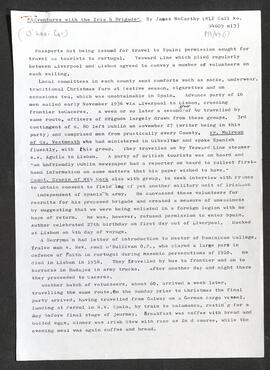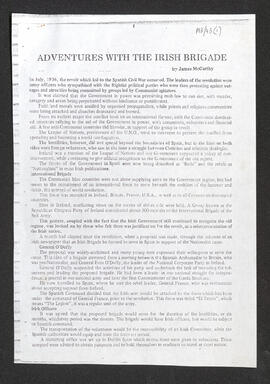Typescript of The Spanish Lady. Pagination.
Walsh, Maurice (1879-1964), writerTypescript draft of the short story The Red Girl in a file cover marked ‘Brandt and Brandt’ with a cover page stamped: ‘Please return to Brandt and Brandt, 101 Park Avenue, New York’. Draft opens: ‘Major-General Kelly-Cuthbert was enjoying his after-dinner cigar on the verandah’. Alterations. Pagination.
Walsh, Maurice (1879-1964), writerTypescript of the adaptation of The Road to Nowhere for stage by Katherine Forbes-Leith (Mrs. Baxter Jackson), 410 Park Avenue, New York, with annotations and alterations by Walsh. Thirty of the original pages have been removed and replaced by others (probably by Walsh). The original sequence of pages has also been altered. The pages removed are grouped together at the back. Also see P12/1/3/2/1 and P7/1/4/2/1-2.
Walsh, Maurice (1879-1964), writerTypescript of poem entitled Glenfinnan signed 'Patrick Little’ [Fianna Fáil politician] which begins: ‘A great quiet now has settled on the glen’.
Walsh, Maurice (1879-1964), writerTypescript of piece entitled ‘Tullamore Distillery, Tullamore, King’s County. Proprietor, Bernard Daly’. On the last page is noted: ‘Extract from “The Whisky Distilleries of the United Kingdom” by Alfred Barnard. Published 1887’. Pagination.
Walsh, Maurice (1879-1964), writerTypescript of part of a draft of the short story Over the Border. Alterations. Pagination.
Walsh, Maurice (1879-1964), writerTypescript of notes based on an essay written by James McCarthy entitled Adventures with the Irish Brigade (for which see P13/1/1/9/1), beginning ‘Passports not being issues for travel to Spain; permission sought for travel as tourists to Portugal’, underlining names of various individuals involved referred to in essay. Includes National Library of Ireland reference number.
Stradling, Robert Arthur, scholarTypescript of memoirs of James McCarthy, of Enniskeane, county Cork, about his experience as a volunteer with Irish Brigade, entitled Adventures with the Irish Brigade, beginning ‘In July, 1936, the revolt which led to the Spanish Civil War occurred’. Records information concerning the outbreak of war, the International Brigade, General Eoin O’Duffy, the transport of volunteers to Spain, Irish government action, the formation of the Brigade, the daily routine, the first casualties, some ‘Personal Adventures’, General O’Duffy’s address and returning home. Paginated.
Stradling, Robert Arthur, scholarTypescript of essay/article entitled ‘The Irish ports and the war. How long can Ireland keep out of it?’ by Walsh. ‘Brandt’ appears in pencil on the first page.
Walsh, Maurice (1879-1964), writerTypescript of draft of the short story The Red Girl beginning with chapter one which opens: ‘The hotel lounge was Big Michael Flynn’s best room: wide and low’. Alterations. Pagination.
Walsh, Maurice (1879-1964), writer
